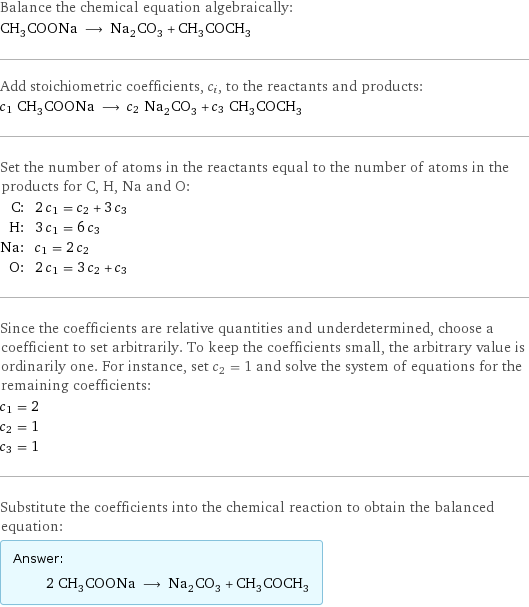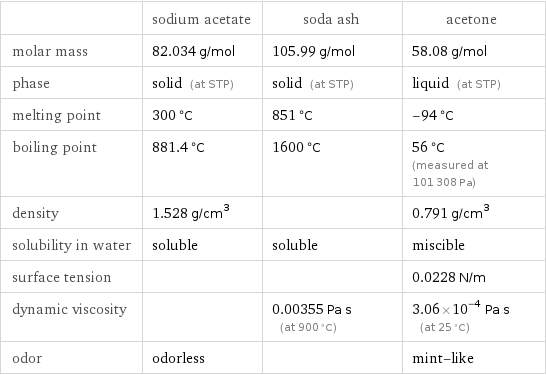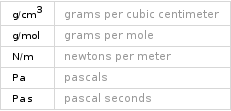Input interpretation

CH_3COONa sodium acetate ⟶ Na_2CO_3 soda ash + CH_3COCH_3 acetone
Balanced equation

Balance the chemical equation algebraically: CH_3COONa ⟶ Na_2CO_3 + CH_3COCH_3 Add stoichiometric coefficients, c_i, to the reactants and products: c_1 CH_3COONa ⟶ c_2 Na_2CO_3 + c_3 CH_3COCH_3 Set the number of atoms in the reactants equal to the number of atoms in the products for C, H, Na and O: C: | 2 c_1 = c_2 + 3 c_3 H: | 3 c_1 = 6 c_3 Na: | c_1 = 2 c_2 O: | 2 c_1 = 3 c_2 + c_3 Since the coefficients are relative quantities and underdetermined, choose a coefficient to set arbitrarily. To keep the coefficients small, the arbitrary value is ordinarily one. For instance, set c_2 = 1 and solve the system of equations for the remaining coefficients: c_1 = 2 c_2 = 1 c_3 = 1 Substitute the coefficients into the chemical reaction to obtain the balanced equation: Answer: | | 2 CH_3COONa ⟶ Na_2CO_3 + CH_3COCH_3
Structures

⟶ +
Names

sodium acetate ⟶ soda ash + acetone
Equilibrium constant
![Construct the equilibrium constant, K, expression for: CH_3COONa ⟶ Na_2CO_3 + CH_3COCH_3 Plan: • Balance the chemical equation. • Determine the stoichiometric numbers. • Assemble the activity expression for each chemical species. • Use the activity expressions to build the equilibrium constant expression. Write the balanced chemical equation: 2 CH_3COONa ⟶ Na_2CO_3 + CH_3COCH_3 Assign stoichiometric numbers, ν_i, using the stoichiometric coefficients, c_i, from the balanced chemical equation in the following manner: ν_i = -c_i for reactants and ν_i = c_i for products: chemical species | c_i | ν_i CH_3COONa | 2 | -2 Na_2CO_3 | 1 | 1 CH_3COCH_3 | 1 | 1 Assemble the activity expressions accounting for the state of matter and ν_i: chemical species | c_i | ν_i | activity expression CH_3COONa | 2 | -2 | ([CH3COONa])^(-2) Na_2CO_3 | 1 | 1 | [Na2CO3] CH_3COCH_3 | 1 | 1 | [CH3COCH3] The equilibrium constant symbol in the concentration basis is: K_c Mulitply the activity expressions to arrive at the K_c expression: Answer: | | K_c = ([CH3COONa])^(-2) [Na2CO3] [CH3COCH3] = ([Na2CO3] [CH3COCH3])/([CH3COONa])^2](../image_source/5751d29b90da520696f194978ec52454.png)
Construct the equilibrium constant, K, expression for: CH_3COONa ⟶ Na_2CO_3 + CH_3COCH_3 Plan: • Balance the chemical equation. • Determine the stoichiometric numbers. • Assemble the activity expression for each chemical species. • Use the activity expressions to build the equilibrium constant expression. Write the balanced chemical equation: 2 CH_3COONa ⟶ Na_2CO_3 + CH_3COCH_3 Assign stoichiometric numbers, ν_i, using the stoichiometric coefficients, c_i, from the balanced chemical equation in the following manner: ν_i = -c_i for reactants and ν_i = c_i for products: chemical species | c_i | ν_i CH_3COONa | 2 | -2 Na_2CO_3 | 1 | 1 CH_3COCH_3 | 1 | 1 Assemble the activity expressions accounting for the state of matter and ν_i: chemical species | c_i | ν_i | activity expression CH_3COONa | 2 | -2 | ([CH3COONa])^(-2) Na_2CO_3 | 1 | 1 | [Na2CO3] CH_3COCH_3 | 1 | 1 | [CH3COCH3] The equilibrium constant symbol in the concentration basis is: K_c Mulitply the activity expressions to arrive at the K_c expression: Answer: | | K_c = ([CH3COONa])^(-2) [Na2CO3] [CH3COCH3] = ([Na2CO3] [CH3COCH3])/([CH3COONa])^2
Rate of reaction
![Construct the rate of reaction expression for: CH_3COONa ⟶ Na_2CO_3 + CH_3COCH_3 Plan: • Balance the chemical equation. • Determine the stoichiometric numbers. • Assemble the rate term for each chemical species. • Write the rate of reaction expression. Write the balanced chemical equation: 2 CH_3COONa ⟶ Na_2CO_3 + CH_3COCH_3 Assign stoichiometric numbers, ν_i, using the stoichiometric coefficients, c_i, from the balanced chemical equation in the following manner: ν_i = -c_i for reactants and ν_i = c_i for products: chemical species | c_i | ν_i CH_3COONa | 2 | -2 Na_2CO_3 | 1 | 1 CH_3COCH_3 | 1 | 1 The rate term for each chemical species, B_i, is 1/ν_i(Δ[B_i])/(Δt) where [B_i] is the amount concentration and t is time: chemical species | c_i | ν_i | rate term CH_3COONa | 2 | -2 | -1/2 (Δ[CH3COONa])/(Δt) Na_2CO_3 | 1 | 1 | (Δ[Na2CO3])/(Δt) CH_3COCH_3 | 1 | 1 | (Δ[CH3COCH3])/(Δt) (for infinitesimal rate of change, replace Δ with d) Set the rate terms equal to each other to arrive at the rate expression: Answer: | | rate = -1/2 (Δ[CH3COONa])/(Δt) = (Δ[Na2CO3])/(Δt) = (Δ[CH3COCH3])/(Δt) (assuming constant volume and no accumulation of intermediates or side products)](../image_source/fe3f3f2c47ab9dd6b899d56a3e667eae.png)
Construct the rate of reaction expression for: CH_3COONa ⟶ Na_2CO_3 + CH_3COCH_3 Plan: • Balance the chemical equation. • Determine the stoichiometric numbers. • Assemble the rate term for each chemical species. • Write the rate of reaction expression. Write the balanced chemical equation: 2 CH_3COONa ⟶ Na_2CO_3 + CH_3COCH_3 Assign stoichiometric numbers, ν_i, using the stoichiometric coefficients, c_i, from the balanced chemical equation in the following manner: ν_i = -c_i for reactants and ν_i = c_i for products: chemical species | c_i | ν_i CH_3COONa | 2 | -2 Na_2CO_3 | 1 | 1 CH_3COCH_3 | 1 | 1 The rate term for each chemical species, B_i, is 1/ν_i(Δ[B_i])/(Δt) where [B_i] is the amount concentration and t is time: chemical species | c_i | ν_i | rate term CH_3COONa | 2 | -2 | -1/2 (Δ[CH3COONa])/(Δt) Na_2CO_3 | 1 | 1 | (Δ[Na2CO3])/(Δt) CH_3COCH_3 | 1 | 1 | (Δ[CH3COCH3])/(Δt) (for infinitesimal rate of change, replace Δ with d) Set the rate terms equal to each other to arrive at the rate expression: Answer: | | rate = -1/2 (Δ[CH3COONa])/(Δt) = (Δ[Na2CO3])/(Δt) = (Δ[CH3COCH3])/(Δt) (assuming constant volume and no accumulation of intermediates or side products)
Chemical names and formulas

| sodium acetate | soda ash | acetone formula | CH_3COONa | Na_2CO_3 | CH_3COCH_3 Hill formula | C_2H_3NaO_2 | CNa_2O_3 | C_3H_6O name | sodium acetate | soda ash | acetone IUPAC name | sodium acetate | disodium carbonate | acetone
Substance properties

| sodium acetate | soda ash | acetone molar mass | 82.034 g/mol | 105.99 g/mol | 58.08 g/mol phase | solid (at STP) | solid (at STP) | liquid (at STP) melting point | 300 °C | 851 °C | -94 °C boiling point | 881.4 °C | 1600 °C | 56 °C (measured at 101308 Pa) density | 1.528 g/cm^3 | | 0.791 g/cm^3 solubility in water | soluble | soluble | miscible surface tension | | | 0.0228 N/m dynamic viscosity | | 0.00355 Pa s (at 900 °C) | 3.06×10^-4 Pa s (at 25 °C) odor | odorless | | mint-like
Units
